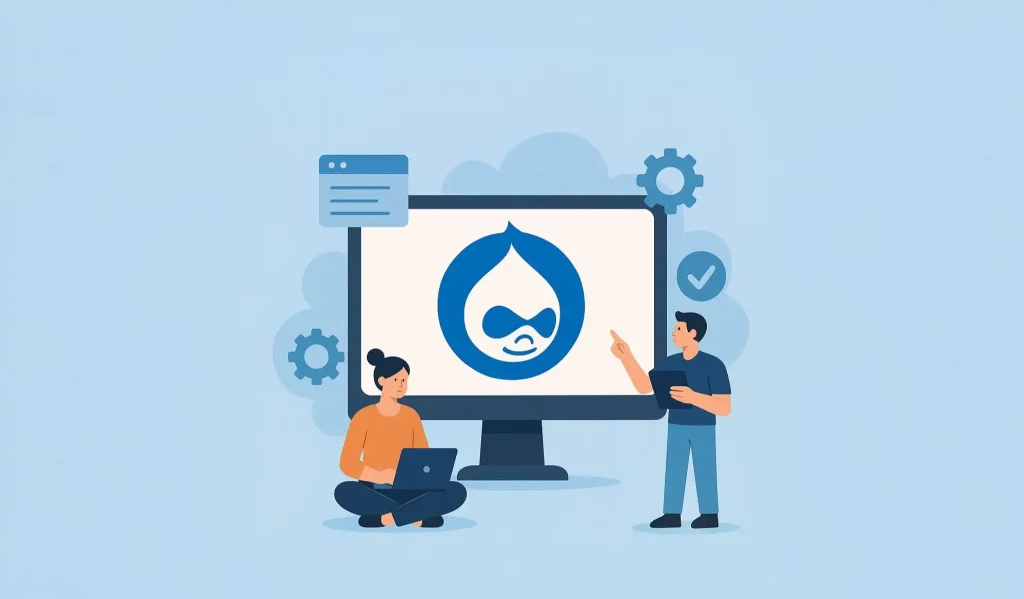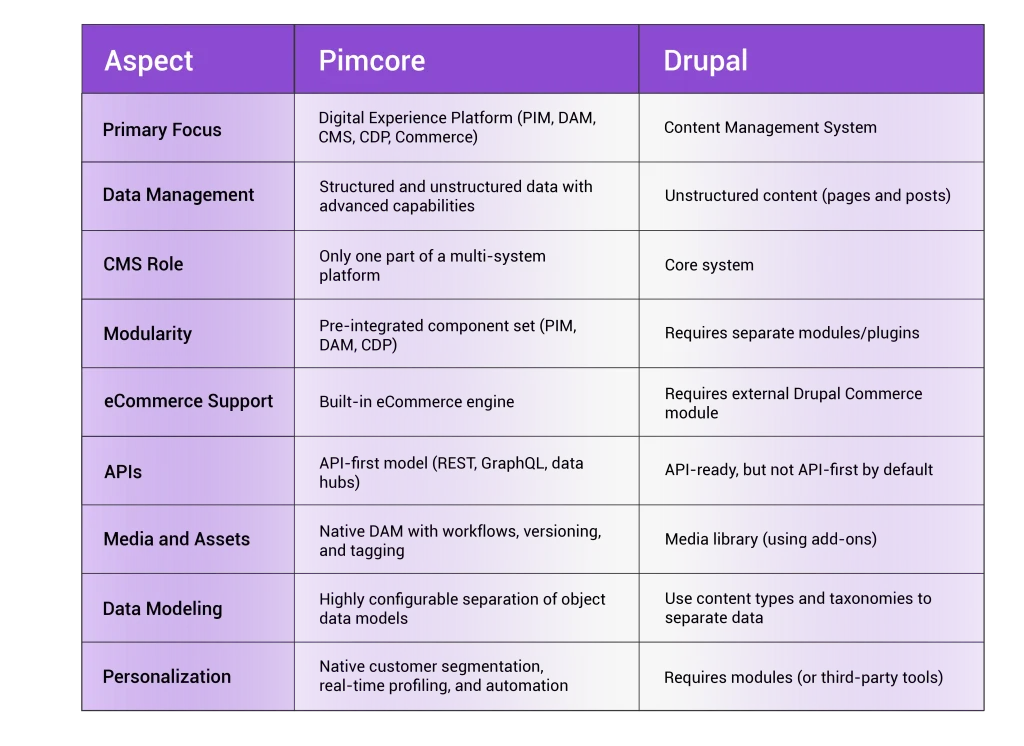- Pimcore is a DX platform that includes PIM, DAM, CMS, CDP, and eCommerce features.
- Drupal is a CMS designed for content-heavy websites, portals, and publications.
- Pimcore is designed for enterprise companies managing complex product data and omnichannel CX.
- Drupal is designed for editorial workflows, modular architecture, and multi-lingual content.
- Both are open source; Pimcore offers enterprise support while Drupal relies on the community.
- Pimcore for unified commerce and data; Drupal for flexible content publishing needs.
When it comes to choosing the right digital platform, launching just a website won’t cut it as businesses are now looking at creating a more connected, intelligent, and scalable digital ecosystem – a system that easily handles content, product information, customer experience, and multi-channel distribution. Within this digital ecosystem framework, two major players often come up in the same sentence – Pimcore and Drupal.
Both are open-source. Both are powerful. Both are adopted by numerous enterprises across the world. But if you think Pimcore and Drupal are two sides of the same coin, think again. While both are PHP-based (furthermore, they utilize the Symfony framework as their basis) and headless, fundamentally, they address different business problems.
In this blog, we are going to explore what Pimcore and Drupal offer. We will compare these two platforms, including their architecture, features, use cases, extensibility, etc.
What is Pimcore?

Pimcore is much more than a content platform; it’s an all-in-one Digital Experience Platform (DXP) drawing together multiple systems into a singular, API-first system (in the digital ecosystem). Including;
- Product Information Management (PIM)
- Digital Asset Management (DAM)
- Customer Data Platform (CDP)
- Master Data Management (MDM)
- Content Management System (CMS)
- Ecommerce Framework
Having Symfony as its building block, Pimcore provides developers with complete freedom over data modeling, workflow setup, and integration with external enterprise systems like ERPs or CRMs.
Pimcore truly excels with its “single source of truth” philosophy, and regardless of whether you manage thousands of SKUs, localize marketing campaigns, or personalize live content, Pimcore is able to offer clarity by consolidating data into one system.
Here’s What Pimcore Offers:
- Manages All Data in One Place: Centralized management of structured and unstructured content (products, articles, images, videos) from one dashboard.
- API-First Configuration: instant and effortless data exchange through REST or GraphQL, which becomes highly useful for headless setups.
- Enterprise-Ready PIM and DAM: Rich media capabilities and product data management, all without additional plugins.
- Personalization and Customer Segmentation: Utilizes built-in features to develop personalized experiences or user segments with the capabilities of a CDP.
- Commerce Integration: A native eCommerce framework, ideal for complex catalog structures and omnichannel selling.
What is Drupal?

Drupal is your one-stop solution for ultimate content management. It offers editorial workflows, extensibility, flexible front-end delivery, and more. On top of that, this open-source platform is built on PHP and used by top organizations, from NGOs and government agencies to media, enterprises, and higher educational organizations.
Drupal is mainly about publishing and managing content at scale. However, contrary to plug-and-play CMSs and their use cases, Drupal is more of a development framework for content. Everything is modular. Everything is configurable.
With Drupal, you can install modules after starting with a lightweight core: you can either install community-contributed modules or custom modules you have written to add further functionalities. From SEO and multilingual content to editorial approvals and API-based delivery, you can configure anything.
Drupal’s Main Capabilities:
- Modular CMS Framework: Customize your site down to the smallest detail with thousands of modules.
- Multilingual Content Out of the Box: Supports 100+ languages natively, making it a truly global player.
- Content Workflow Engine: Supports content teams with easy collaboration, thanks to highly advanced publishing flows, editorial tools, and roles.
- Highly Scalable: Has a positive track record of offering unmatched scalability for high-traffic sites like media houses or government portals.
- Headless & Decoupled CMS: Leverages GraphQL or JSON:API to ensure seamless content delivery across mobile, web, and IoT.
Architecture & Core Functional Differences

So, while Drupal allows you to develop great websites, Pimcore lets you build exceptional ecosystems. Drupal is best when content is king. Pimcore is built for enterprises juggling products, customers, assets, and experiences at once.
When to Consider Pimcore vs Drupal
Both Pimcore and Drupal can be molded into flexible, enterprise-quality platforms – but they do not solve the same problems. Choosing between these products comes down to the type of digital experience that you are looking to create.
When Pimcore is the right choice:
- Your product catalog is complicated: You’re managing thousands of SKUs with hundreds of attributes, categories, and media files. Pimcore’s PIM was built for this.
- One digital hub is your answer: If your organization is struggling with siloed content, scattered product data, customer data, or marketing content elsewhere, Pimcore brings everything under one roof.
- You want an omnichannel experience: You can distribute product data and content to various front-ends, including apps, POS, kiosks, websites, marketplace, and more.
- Commerce doesn’t just mean shopping cart: If you want to shift from just regular digital commerce to a more modern omnichannel experience, pick Pimcore. Whether it’s customer-specific pricing, huge catalog data, business rules, or configurable products, the native commerce engine of Pimcore is way superior to Drupal.
- Your content is as important as your design: When it comes to automation, workflows, integrations, and structured data modeling, Pimcore offers an unmatched experience.
When to Consider Drupal:
- You want to build a content-rich website or portal: Drupal has the tools to excel at managing and publishing high volumes of editorial content and is perfect for news media conglomerates, universities, governments, or NGOs.
- You want modular flexibility: Drupal offers the modular flexibility that you need when you have to choose from a huge library of community-contributed modules.
- You’ve got a dedicated development team: Drupal is not for every user because of the technicalities that require developers’ attention. But with qualified developers, you can configure almost anything into Drupal.
- You need to build complex multilingual capabilities: Drupal’s native language structure has been thoroughly proven and has been developed with real-world usage in mind.
- You’re already using Drupal: If you or your organization is already working with Drupal, it’s wiser to stick to it. You will have a much easier learning curve compared to switching to a whole different system.
Pimcore vs Drupal: Customization and Developer Experience
Pimcore:
- Built on Symfony, it features clean, object-oriented programming.
- Customization is largely PHP-based with strong APIs and data modeling tools.
- UI is modern, but there’s a learning curve when managing large datasets.
- ERP and CRM integration are the primary focus – great for enterprise workflows.
Bottom line: Pimcore is for developers who understand Symfony and want to model complex business data. It’s less about plugins and more about system orchestration.
Drupal:
- Also built on Symfony, but with a steeper learning curve due to its own unique vocabulary (nodes, hooks, entities).
- Thousands of modules make coding less necessary but result in “dependency hell” if not managed carefully.
- Frontend theming is flexible but complex.
- Community documentation is excellent and extensive.
Bottom line: Drupal rewards experienced developers with near-limitless customization. Be prepared for a longer ramp-up and occasional module conflict.
Scalability and Performance
Drupal:
- Designed to cache heavily using Varnish, Memcached, and CDN.
- Scales horizontally with the right level of optimization.
- Backend performance is impacted by module bloat – multiple badly designed modules can slow it down.
- For high-traffic publishing portals or with complex content hierarchies, Drupal is solid.
Pimcore:
- Data-centric by design and optimized for large amounts of structured and media-rich content.
- Caching layers and background-task queues help to speed up heavy-load scenarios.
- Almost any platform can be set up to scale horizontally, especially in containerized environments.
- Strongest scenarios are those in which product and asset data fuel the content delivery.
Pimcore vs. Drupal
Pimcore: Pros
- Native PIM, DAM, CMS, and CDP; all in one DXP
- Includes an eCommerce Framework
- One central data hub for the Omnichannel experience
- Integrates seamlessly into enterprise systems.
- Robust backend built on Symfony – a program that can be easily extended
- API-centric design that supports headless and hybrid architecture (API first)
Pimcore: Cons
- Developers must have knowledge based on Symfony and data modeling
- Smaller developer community compared to Drupal
- Steeper learning curve for non-technical users
- Fewer design templates or themes out of the box
Drupal: Pros
- Mature CMS with a large global community
- Thousands of viable modules and themes to use
- Excellent for content-heavy websites and publishing workflows
- Good multilingual and accessibility support
- Robust editorial tools and granular permissions
Drupal: Cons
- Can lead to custom modules for advanced features
- Can become bloated if too many plugins are used
- To customize decisively, some level of technical skill is required
- No native PIM, DAM, or commerce engine; needs integrations
Licensing and Cost Considerations
One of the main draws for both Pimcore and Drupal is their open-source nature, but that doesn’t always translate into actual cost in the real world.
Pimcore
Pimcore comes in two editions:
- Community Edition: 100% free and open-source under the GPLv3 license. You get all core functionalities, like CMS, PIM, DAM, CDP, and eCommerce framework, with this edition.
- Enterprise Subscription: Paid option for large businesses that need enterprise support, long-term release support (LTS), SLA guarantees, and advanced features.
While you get free support through the Community Edition (which is really powerful), many businesses opt for the subscription to get certified modules, sophisticated deployment tools, and technical support.
Cost Impact:
- Free to use, but development costs are higher due to customization and integration.
- You’ll likely need a Symfony-experienced development team or an agency familiar with Pimcore to get the most out of it.
- Long-term maintenance is efficient once the system is built properly.
Drupal
Under the GPLv2+ license, Drupal is also 100% free and open-source in nature. There’s no enterprise edition or central company offering commercial support. Support comes from agencies, consultants, and the community.
Cost Impact:
- Free to use with no licensing tiers.
- Custom development and site maintenance can get costly over time, especially when building complex architectures with contributed modules.
- You’ll need dedicated developers who know Drupal’s ecosystem, which has its own idiosyncrasies and rules.
Bottom Line:
- Drupal is great for teams that want full control with community-driven support.
- Pimcore is better for enterprises that want unified functionality with the option of enterprise-grade support.
Final Verdict
If you want to develop a highly customized, content-heavy eCommerce store or site, Drupal is a no-brainer. Its modular system, large community, and deep configuration possibilities make it ideal for content-heavy use cases with complex editorial structures.
But if your business is about products, data, and digital commerce, Pimcore has something Drupal doesn’t: a platform where content, product data, media, customer profiles, and sales funnels all live in the same place.
Pimcore is built for companies that have outgrown their CMS and need a data-driven DXP. Drupal is built for those who need a highly flexible content publishing engine.
So, it’s not about which platform is “better.” It’s about what suits your individual requirements.
FAQs
Many say Pimcore outshines WordPress or Drupal when managing thousands of products or structured assets, but it requires Symfony-savvy developers and has a steeper learning curve.
Drupal excels for presenting data, but not as a data warehouse. Tools like Views and connectors help reporting, but analytics and real data lakes require separate solutions.
Pimcore’s Reddit community is quiet, but official communication happens via GitHub Discussions and Gitter. Most project support occurs through its 82,000+ company user base.
Some developers describe Pimcore as a “better WordPress” for complex apps, with powerful Symfony-based architecture, though it’s meant more as a framework than a straightforward CMS.
Many praise Pimcore for superior code quality compared to Joomla, Drupal, or WordPress. But mastering it demands Symfony proficiency and some patience to learn.









